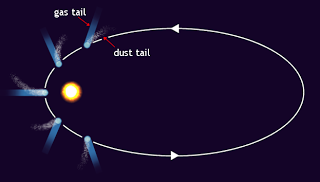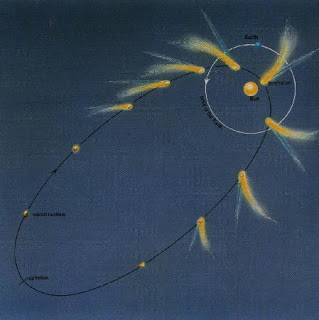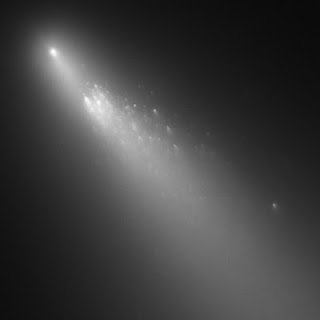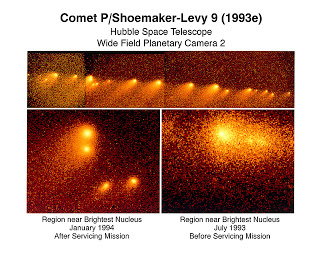Astronomy

Chinese astronomers kept extensive records on comets for centuries, including observations of Halley's Comet going back to at least 240 BC, historic annals that have proven valuable resources for later astronomers.


Asteroids classify comets based on the durations of their orbits around the sun. Short-period comets need roughly 200 years or less to complete one orbit, long-period comets take more than 200 years, and single-apparition comets are not bound to the sun, on orbits that take them out of the solar system. Recently, scientist have also discovered comets in the main asteroid belt ? these main-belt comets might be a key source of water for the inner terrestrial planets.
Scientists think short-period comets, also known as periodic comets, originate from a disk-shaped band of icy objects known as the Kuiper belt beyond Neptune's orbit, with gravitational interactions with the outer planets dragging these bodies inward, where they become active comets. Long-period comets are thought to come from the nearly spherical Oort cloud even further out, which get slung inward by the gravitational pull of passing stars.
Some comets, called sun-grazers, smash right into the sun or get so close that they break up and evaporate



- Messier Objects
Messier Objects ...
- Picture Of The Day - Nov 5
Picture Of The Day 2012 November , 5 ...
- Comet - 1
Comets -1 ...
- Picture Of The Day Oct - 25
Picture Of The Day October 25 , Thursday The Cone Nebula (NGC 2264) ...
- Picture Of The Day
Picture Of The Day October 17, Wednesday ...
Astronomy
Comet-2
Comet - 2

Comets inspired both awe and alarm, "hairy stars" resembling fiery swords that appeared unpredictably in the sky. Often, comets seemed to be omens of doom ? the most ancient known mythology, the Babylonian "Epic of Gilgamesh," described fire, brimstone, and flood with the arrival of a comet, and Emperor Nero of Rome saved himself from the "curse of the comet" by having all possible successors to his throne executed. This fear was not just limited to the distant past ? in 1910, people in Chicago sealed their windows to protect themselves from what they thought was the comet?s poisonous tail.
For centuries, scientists thought comets traveled in the Earth's atmosphere, but in 1577, observations made by Danish astronomer Tycho Brahe revealed they actually traveled far beyond the moon. Isaac Newton later discovered that comets move in elliptical, oval-shaped orbits around the Sun, and correctly predicted that they could return again and again.Chinese astronomers kept extensive records on comets for centuries, including observations of Halley's Comet going back to at least 240 BC, historic annals that have proven valuable resources for later astronomers.
Orbital Characteristics :


Asteroids classify comets based on the durations of their orbits around the sun. Short-period comets need roughly 200 years or less to complete one orbit, long-period comets take more than 200 years, and single-apparition comets are not bound to the sun, on orbits that take them out of the solar system. Recently, scientist have also discovered comets in the main asteroid belt ? these main-belt comets might be a key source of water for the inner terrestrial planets.
Scientists think short-period comets, also known as periodic comets, originate from a disk-shaped band of icy objects known as the Kuiper belt beyond Neptune's orbit, with gravitational interactions with the outer planets dragging these bodies inward, where they become active comets. Long-period comets are thought to come from the nearly spherical Oort cloud even further out, which get slung inward by the gravitational pull of passing stars.
Some comets, called sun-grazers, smash right into the sun or get so close that they break up and evaporate
Formation :
Astronomers think comets are leftovers from the gas, dust, ice and rocks that initially formed the solar system about 4.6 billion years ago.
Comet Life Cycle :
- Some comets are not bound to the sun, on orbits that take them out of the solar system.
- Comets lose ice and dust each time they come near the sun, leaving behind trails of debris. Eventually, they can lose all their ices, with some turning into fragile, inactive objects similar to asteroids.
- Other comets, upon losing all their ices, break up and dissipate into clouds of dust.
- The orbits comets take sometimes end with them colliding with planets and their moons. Many impact craters seen in the solar system were caused by such collisions.

( Comet Breakup )


- Messier Objects
Messier Objects ...
- Picture Of The Day - Nov 5
Picture Of The Day 2012 November , 5 ...
- Comet - 1
Comets -1 ...
- Picture Of The Day Oct - 25
Picture Of The Day October 25 , Thursday The Cone Nebula (NGC 2264) ...
- Picture Of The Day
Picture Of The Day October 17, Wednesday ...
